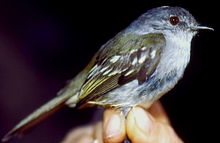| Foothill elaenia | |
|---|---|

| |
| Conservation status | |
 Least Concern (IUCN 3.1) | |
| Scientific classification | |
| Domain: | Eukaryota |
| Kingdom: | Animalia |
| Phylum: | Chordata |
| Class: | Aves |
| Order: | Passeriformes |
| Family: | Tyrannidae |
| Genus: | Myiopagis |
| Species: | M. olallai |
| Binomial name | |
| Myiopagis olallai Coopmans & Krabbe, 2000 | |

| |
The foothill elaenia (Myiopagis olallai) is a species of bird in subfamily Elaeniinae of family Tyrannidae, the tyrant flycatchers. It is found in Colombia, Ecuador, Peru, and Venezuela.
Taxonomy and systematics
The foothill elaenia has three subspecies, the nominate M. o. olallai (Coopmans & Krabbe, 2000), M. o. coopmansi (Cuervo, Stiles, Lentino, Brumfield & Derryberry, 2014), and M. o. incognita (Cuervo, Stiles, Lentino, Brumfield & Derryberry, 2014).
Description
The foothill elaenia is 12 to 12.5 cm (4.7 to 4.9 in) long. The sexes have the same plumage. Adults of the nominate subspecies have a dark gray crown with a partially concealed white stripe along its middle. They have a mottled gray and white loral spot, eyering, and lower face. Their upperparts are olive green. Their wings are dusky with thin olive green edges on the primaries and pale yellow edges on the other flight feathers. Pale yellow tips on the wing coverts form three bars on the closed wing. Their tail is browner than the wings and the feathers have thin olive green edges. Their throat is whitish with faint gray mottling. The rest of their underparts are sulphur yellow with olive markings on the lower throat and breast. Subspecies M. o. coopmansi has an unmarked pale olive-gray breast and a whitish belly with little or no yellow. M. o. incognita has a pale gray throat, a pale grayish olive breast, and a pale gray belly. Both sexes of all subspecies have a brown iris, a blackish maxilla, a blackish mandible with a brownish gray or gray-brown base, and blackish legs and feet.
Distribution and habitat
The foothill elaenia has a disjunct distribution. The nominate subspecies is found locally on the east side of the Andes in both northern and southern Ecuador and also in south-central Peru's Cordillera Vilcabamba. It might also occur between these isolated areas, and there is also at least one record in southern Colombia. Subspecies M. o. coopmansi is found at the north end of Colombia's Central Andes in Antioquia Department. M. o. incognita is known only from three specimens collected on the Venezuelan side of the Serranía del Perijá but is assumed to also be on the Colombian side. The species inhabits the interior and edges of humid montane forest. In elevation it occurs between 1,000 and 1,500 m (3,300 and 4,900 ft) in Ecuador, at about 900 m (3,000 ft) in Peru, and at about 1,100 m (3,600 ft) in Venezuela.
Behavior
Movemement
The foothill elaenia is assumed to be a year-round resident throughout its range.
Feeding
The foothill elaenia's diet has not been studied but it is know to feed on insects. It typically forages in pairs associated with a mixed-species feeding flock. It forages from the forest's mid level to the canopy, taking prey mostly while briefly hovering after a short sally from a perch.
Breeding
Nothing is known about the foothill elaenia's breeding biology.
|
Songs and calls Listen to the foothill elaenia on xeno-canto |
Vocalization
What are thought to be songs of the nominate subspecies of the foothill elaenia are "a rapid, descending trilled t'teerrr, and a longer, rising trilled t'teerrreeeeeee"; it also makes "a rising series, tew-tew-tew" which sometimes is extended into a trill. The song of subspecies M. o. coopmansi is similar but longer and faster paced. That of M. o. incognita is unknown.
Status
The IUCN originally in 2002 assessed the foothill elaenia as Near Threatened, then in 2011 as Vulnerable, and since 2019 as being of Least Concern. Its population size is not known and is believed to be decreasing. No immediate threats have been identified. The "Foothill Elaenia is very vulnerable to habitat loss. The narrow elevational band that it occupies along the lower eastern slopes of the Andes is 'disappearing at an alarming rate', primarily by clearing for subsistence agriculture".
References
- ^ BirdLife International (2019). "Foothill Elaenia Myiopagis olallai". IUCN Red List of Threatened Species. 2019: e.T22729451A154077532. doi:10.2305/IUCN.UK.2019-3.RLTS.T22729451A154077532.en. Retrieved 24 September 2024.
- ^ Gill, Frank; Donsker, David; Rasmussen, Pamela, eds. (August 2024). "Tyrant flycatchers". IOC World Bird List. v 14.2. Retrieved 19 August 2024.
- ^ Coopmans, P., and N. Krabbe. 2000. A new species of flycatcher (Tyrannidae: Myiopagis) from eastern Ecuador and eastern Peru. Wilson Bulletin 112: 305-312
- ^ Cuervo, A.M., F.G. Stiles, M. Lentino, R.T. Brumfield, and E.P. Derryberry. 2014. Geographic variation and phylogenetic relationships of Myiopagis olallai (Aves: Passeriformes; Tyrannidae), with the description of two new taxa from the Northern Andes. Zootaxa 3873: 1–24
- ^ Schulenberg, T. S. and G. M. Kirwan (2020). Foothill Elaenia (Myiopagis olallai), version 1.0. In Birds of the World (T. S. Schulenberg, Editor). Cornell Lab of Ornithology, Ithaca, NY, USA. https://doi.org/10.2173/bow.fooela1.01 retrieved September 24, 2024
- ^ Hilty, Steven L. (2003). Birds of Venezuela (second ed.). Princeton NJ: Princeton University Press. p. 568.
| Taxon identifiers | |
|---|---|
| Myiopagis olallai |
|
